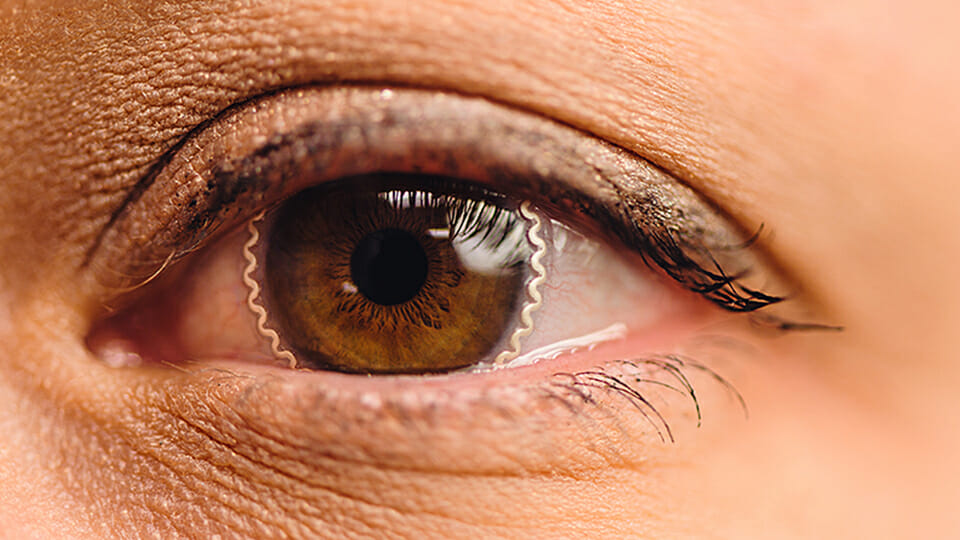Startup battles blindness with high-tech contact lens
Subscriber Benefit
As a subscriber you can listen to articles at work, in the car, or while you work out. Subscribe Now
Glaucoma is a leading cause of blindness in the U.S., but more than half of cases are undiagnosed because early warning signs are virtually unnoticeable. Slowing the disease with earlier treatment is the best way to maintain vision, and that’s why an Indianapolis-based startup has its sights set on commercializing high-tech contact lenses developed at Purdue University that could diagnose glaucoma and delay its progression.
Glaucoma is known to cause the most damage during sleep, but leaders at BVS Sight Inc. say the smart lenses could even wake patients to protect them from the “insidious” disease.
Glaucoma is caused by increased intraocular pressure (IOP), or pressure in the eye, that damages the optic nerve, leading to progressive vision loss. Dr. Chi Hwan Lee, the Leslie A. Geddes Associate Professor of Biomedical Engineering at Purdue, says the condition is often called “the silent death of sight” because patients experience no pain or early warning signs.
IOP is typically monitored only during a clinical visit, during which doctors use a tonometer to take the measurement. But most patients only visit the eye doctor once or twice a year, “so you go pretty far in between having your disease inspected or monitored,” said BVS Sight CEO Nadine Melind.
An office tonometer also provides only a snapshot measurement, but IOP is known to fluctuate throughout the day based on the body’s position and is typically highest while sleeping.
“That means you’re losing your eyesight without even noticing it while you’re sleeping; that’s the biggest problem right now,” said Lee, who is also co-founder and chief scientific officer of BVS Sight. “And this is irreversible vision loss; once you lose your eyesight, there’s no way to recover it.”
Because there’s no cure for glaucoma; lowering IOP is the only proven strategy to delay vision loss. Lee says his discovery will potentially give patients the power to monitor their IOP continuously—not just in the doctor’s office—and proactively reduce IOP when it creeps higher; medicated eyedrops are the first-line treatment to reduce IOP.
In his Purdue lab, Lee has invented a technology that “prints” an IOP monitor onto commercially available soft contact lenses for “24-hour monitoring of IOP – at any time and any place – so you can measure IOP even during sleep.” Lee is also collaborating with the Indiana University School of Optometry.
“We’ve developed a unique printing technique that means you can print this biocompatible, stretchable polymer material [that contains the IOP sensor] on water-soluble tape first,” says Lee. “Then we transfer this printed IOP sensor onto a commercial contact lens after removing the water-soluble tape in water.”
Lee says his eye monitoring technology can be “printed” on any commercially available smart contact lens.
Lee’s lab specializes in these “sticktronics”—sticker-like items containing electronics or smart technology—that can be used to create wearable medical devices.
“You can also think about this device as an alarm; whenever you have higher IOP…it can send the data to your smartphone and generate some kind of an alarm to wake you up,” says Lee. “You can change your posture and immediately decrease your IOP value or, if necessary, you can apply eye drops to reduce IOP.”
Another contact lens sensor for IOP, the SENSIMED Triggerfish, is already on the market, but Lee says long-term wear is limited “due to discomfort and safety concerns,” because the technology is built on a plastic-based, custom-made lens. This increases the thickness and stiffness of the lens, compared to the commercial soft contact lenses Lee uses.
Melind said Lee’s invention was “very, very compelling” to Boomerang Ventures, a venture studio that focuses on connected health technologies, where she’s also an Entrepreneur in Residence. BVS Sight is the first company launched through a partnership between Boomerang and the Purdue Research Foundation.
“There are several companies out there trying to enter this market, but their solutions aren’t nearly as elegant—yet straightforward—as Dr. Lee’s solution,” says Melind. “When you look at the number of people who have glaucoma, it’s a pretty compelling story—and the numbers are growing 25% every decade. Frankly, the size of the market is unfortunately large, but fortunately for a startup, quite significant.”
Melind says BVS Sight’s dedication and strong “founder fit” will help the startup be successful.
BVS Sight is now working on the technology’s regulatory pathway and plans to open a seed round of funding in the coming months. In addition to Lee’s own mother who is battling glaucoma, his motivation is to help the 3 million Americans with the disease—about half of whom don’t even know it.
“As an engineer, my ultimate goal is to empower these patients and help them get control of their condition,” says Lee. “I want to bring our technology out of the university and make a real-world path to longer, healthier and more fulfilling lives.”
Lee says his lab will continue to fine-tune the technology and explore other potential applications for the smart contact lens.
